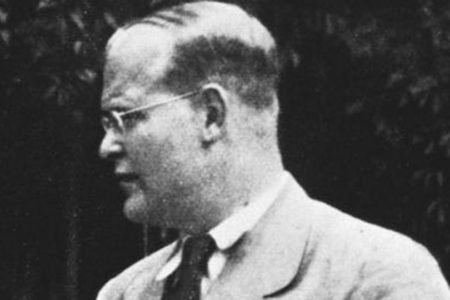The Fiery Trial
Jesus and the apostles said it would take place. Listen to their solemn warnings:
“Blessed are they who are persecuted for righteousness’ sake; for theirs is the kingdom of heaven. Blessed are ye, when men shall revile you, and persecute you, and shall say all manner of evil against you falsely, for my sake” (Mt. 5:10–11). “Yea, and all that will live godly in Christ Jesus shall suffer persecution” (2 Tim. 3:12). “Yet, if any man suffer as a Christian, let him not be ashamed, but let him glorify God on this behalf” (1 Pet. 4:16).
And yet, even though they were warned, the early Christians probably did not fully realize how serious the persecution would eventually become. John Foxe’s classic volume, Book of Martyrs, describes in rather gruesome detail the horrors of the arena, the stake, and the wild beasts that comprised much of the persecution of Christians during the first three centuries before relief came from “the fiery trial” (1 Pet. 4:12). Later Christians so honored these martyrs that they inaugurated pilgrimages to their graves and venerated supposed relics of their bones.
In light of these accounts, the image that most modern Christians have of the early church is one of continuous persecution and worship in secret, lest they be discovered. A closer examination of the history reveals sporadic outbursts of persecution with long periods of relative peace and grudging tolerance. This is not meant to minimize the seriousness of the persecutions; it is only meant to emphasize that three hundred years is a very long time and that the picture of one unending experience of suffering is greatly overdrawn. What do we know about this period from the resurrection of the Messiah (around 30 A.D.) to the Edict of Toleration (around 312 A.D.)?
Persecution by Jewish Leaders
The Book of Acts provides the earliest information about how believers were opposed by the Jewish leaders of the period, both in the land of Israel and also in the Diaspora. Acts 3–5 records the conflicts the apostles had with Jerusalem’s religious leaders. While the common people listened with attention, the Sanhedrin attempted, by imprisonment and beating, to squelch the young Messianic movement. They failed, and the advice of “Rabban Gamaliel” generally prevailed: Leave them alone—if it is not of God, it will come to naught. However, this counsel did not prevent either the stoning of Stephen (Acts 7) or a general persecution launched by the leadership against the Jerusalem believers (Acts 8:1). Readers familiar with Paul’s life will recall that before his conversion he was the chief exponent of exposing those belonging to “the Way” and bringing them to religious trial (Acts 9:1ff.). A study of the apostle’s ministry labors indicates that local Jewish leaders often opposed his ministry and sought to prevent Jewish people from responding to the message of the Messiah (Acts 13–18).
In spite of these facts, Jewish opposition to Jesus’ followers, while very real, was rather mild compared to the fierceness of the later Roman persecution. The execution of individuals like Stephen was extremely rare in the Jewish community. The pressure was more in the realm of banishment from the synagogue (ca. 80 A.D.) and later even banishment from the Jewish community (132 A.D.). This is not said to minimize the emotional pain that Jewish believers must have experienced when family members rejected them (an experience that remains today). To be accused of being a traitor to your people and an apostate from the faith is extremely painful, to say the least. It is noted only to place their suffering in the context of the physical threat to life and limb that eventually came from the Roman authorities.
Persecution by Roman Leaders
In the first few decades of the church’s existence, the Roman authorities simply couldn’t figure out what to do with these Messianic believers who eventually came to be called “Christians” (Acts 11:26). The first indication of this is the statement by the Roman official Gallio, who considered the uproar in the Corinthian synagogue over Paul’s preaching to be an entirely Jewish matter with which he refused to deal (Acts 18:12–17). This incident indicates that the Romans considered “the Way” to be simply a sect within Judaism at that time (around 52 A.D.). The Romans did not tolerate new religions, but they recognized Judaism as an old religion and granted it the status of a religio licita (lit., a legal religion). As long as Christianity was viewed in this manner, it may have been persecuted within the Jewish community, but the Romans tolerated it as a “Jewish sect” and allowed it to exist.
This situation would eventually change. The break between synagogue and church, called the “parting of the ways” in historical sources, led to this change. Once it became clear that the Jewish Christians were no longer welcome in the Jewish community, the Romans began to consider the new faith as just that—something new and, therefore, illegal. As more and more Gentiles came to faith in this Jewish Messiah, it became obvious that this movement was not just a Jewish sect but a new factor in the Roman world. And yet, the persecution began and continued only sporadically.
Paul’s experience in being rescued from a mob in the Jewish Temple actually led to a Roman imprisonment in Caesarea, where he was accused by the Jewish leaders (Acts 21–25). When the Roman procurators bowed to Jewish pressure, Paul appealed to Rome and was sent there (Acts 26–28). It was while in the custody of Roman guards that he faced a defense before the deranged Roman Emperor Nero. This emperor evidently was the first one to outwardly persecute Christians. The Book of Acts ends with Paul in Roman custody, but early church tradition states that he was beheaded for his faith sometime around 65 to 66 A.D. Peter also suffered the same fate, if we can believe the sources, but was crucified upside down rather than beheaded. Roman historians record that Nero blamed the great fire in Rome on the Christians in the city and issued orders to punish them, actually burning many of them alive on crosses to “decorate” his gardens! This was the first official Roman persecution of Christians. However, it was limited to Rome and was not empire-wide.
The Neronian persecution apparently ceased with the mad emperor’s death in 68 A.D. While Christians continued to be ridiculed, they did not openly suffer physically again until around 95 A.D., when the Emperor Domitian evidently launched another persecution focused on believers in Asia Minor (present-day western Turkey). During this time, the Apostle John was banished to the Island of Patmos, just 20 miles off the coast of Asia Minor, where he received the Apocalypse (Rev. 1:9). There is some evidence of persecution taking place in Bythinia in northern Turkey in the early decades of the second century. This is found in the correspondence of “Pliny the Younger” with the Emperor Trajan around 115 A.D. Trajan advised this official not to seek out these Christians; but, if they were accused, he was to urge them to recant by offering incense to the Emperor. If they did not recant, they were to be put to death.
During this period, the great Ignatius, Bishop of the church in Antioch, was executed in Rome. His epistles actually record that he was looking forward to the great privilege of dying for the Savior. The second century witnessed an increase in Roman persecutions. Some heroic accounts survive that move us today by their testimonies of faith and courage. One of the best known is “The Martyrdom of Polycarp.” Listen to part of an eyewitness account of the martyrdom of this Bishop of Smyrna in western Asia Minor.
And as he was brought forward, the tumult became great when they heard that Polycarp was taken. And when he came near, the proconsul asked him whether he was Polycarp. On his confessing that he was, [the proconsul] sought to persuade him to deny [Christ], saying, “Have respect to thy old age,” and other similar things, according to their custom [such as], “Swear by the fortune of Caesar; repent, and say, Away with the Atheists.” But Polycarp, gazing with a stern countenance on all the multitude of the wicked heathen then in the stadium, and waving his hand towards them, while with groans he looked up to heaven, said, “Away with the Atheists.” Then, the proconsul urging him, and saying, “Swear, and I will set thee at liberty, reproach Christ;” Polycarp declared, “Eighty and six years have I served Him, and He never did me any injury: how then can I blaspheme my King and my Savior?”
The account continues with further appeals to the aged man to renounce his faith, accompanied by threats to have him burned. His response was firm: “You try to frighten me with the fire that burns for an hour and you forget the fire of hell that never goes out.” So Polycarp, praying that his death would be an acceptable sacrifice, was burned at the stake.
Why did the Roman officials persecute the Christians? Why didn’t they also persecute other new religions in the way they did this “new” faith? Justin Martyr, writing around the middle of the second century before his own martyrdom in Rome, listed four charges brought against the believers and showed how groundless each of them actually was. Some of them sound strange and ridiculous to us. First, Christians were accused of being “atheists.” This meant that they did not believe in the physical and visible gods of the ancient pagan religions. They worshipped an invisible God—something the pagan Romans could not comprehend. Second, they were accused of “immorality.” This arose from a gross misrepresentation of the early Christian “love feasts” as well as referring to each other as “brother” and “sister” (incest?). Their meetings in secret, due to necessity, furthered these suspicions. Third, their refusal to worship the emperor by burning incense to him led to the charge of “treason,” since this was viewed as a political act in addition to a religious act. Fourth, their separation from worldly amusements (e.g., the brutal gladiatorial fights) led to the general charge of “contrariness” and “public nuisances.”
Of course, these charges were absurd, to say the least. The behavior of Christians in not exposing unwanted children, but rather rescuing and adopting them, treating slaves with compassion (see the Book of Philemon), and caring for the sick and elderly actually showed them to be exemplary in their conduct. Their honorable behavior and faithful witness in the face of death eventually shamed many of their tormentors into recognizing the reality and sincerity of their faith.
In spite of these facts, there was never an empire-wide effort to destroy Christians until the third century. The persecutions under the Emperors Decius (249–251 A.D.) and Diocletian (303–311 A.D.) were the most systematic and were directed at their annihilation. During these terrible times, such leaders as Cyprian, Origen, and Hippolytus paid for their faith with their lives. Along with them and other leaders, thousands were tortured, burned, and devoured, often as sport for the masses. But the attempts to obliterate the faith were unsuccessful. The testimony of these “witnesses” (the Greek word for witness came to be the word for martyr) in the face of death often led their persecutors to become Christians. It was Tertullian who made the oft-quoted remark, “The blood of the martyrs becomes their seed!”
The Diocletian persecution, with all of its ferocity, actually became the storm before the calm. In 312 A.D., the future Emperor Constantine, along with other rulers vying for the throne, issued the Edict of Toleration, which, at long last, legalized the “new” faith. Overnight, so to speak, the horror of the last and worst persecution of Christians ended. For nearly three hundred years, believers in Jesus had been successively ridiculed, humiliated, shamed, mocked, slandered, hunted down, tortured, and murdered. While there were some who lapsed in the face of the trial (hadn’t Jesus warned of this in Mt. 24:12?), there are a multitude of accounts that testify to the fortitude of the believers’ faith in the face of death. It is true that there were periods of relative calm during those centuries. It is also true that more people have died for Christ in the 20th century than in any previous period of church history. These facts, however, do not mitigate the tremendous example of “that noble army of martyrs” who, in the face of pressure to deny Christ, paid the ultimate sacrifice.
In describing the sufferings of believers in the future, John gives us the secret of the victory of saints throughout the ages: “And they overcame him [Satan] by the blood of the Lamb, and by the word of their testimony; and they loved not their lives unto the death” (Rev. 12:11).







